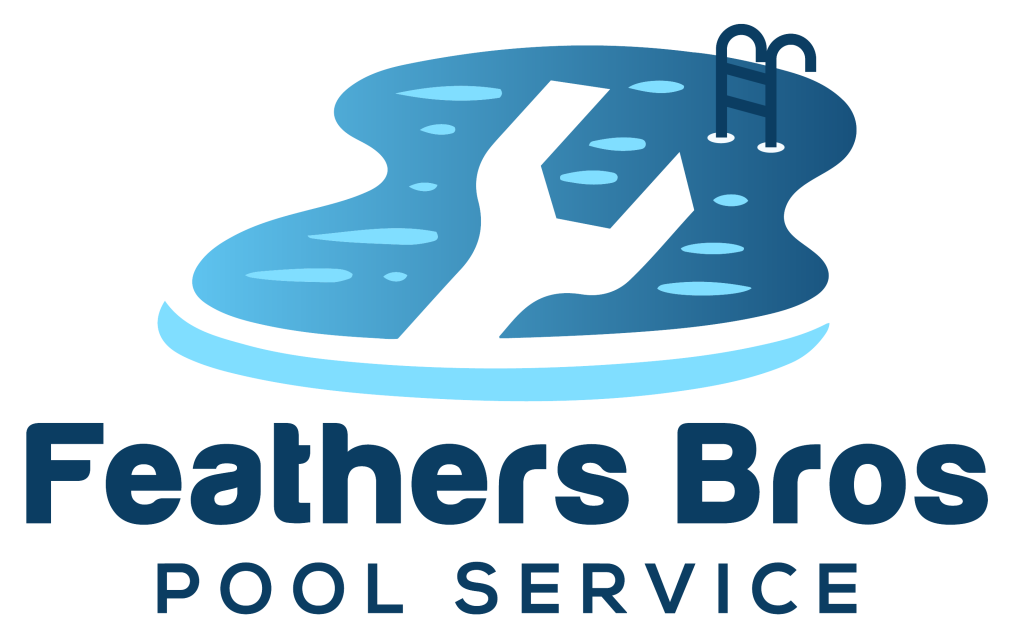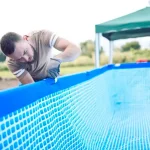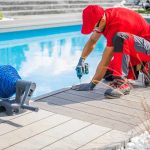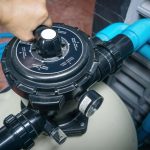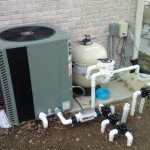Owning a pool can be one of the greatest joys of homeownership. There’s nothing quite like a refreshing dip on a hot summer day or the joy of hosting a poolside barbecue for friends and family. However, a sparkling, clear pool doesn’t happen by luck. Behind every pristine swimming pool lies a solid maintenance routine.
For a hassle-free start to the swim season, trust Feathers Bros Pool Service for professional pool opening services in Indianapolis, IN. We’ll ensure your pool is clean, safe, and ready for fun all summer long!
1. Skim and Clean Regularly
Your first step to a clean pool is regular skimming. Leaves, bugs, and other debris are inevitable, but letting them sit can cause grime and algae.
How to do it effectively:
- Use a pool skimmer net or a leaf rake daily, especially during fall or windy days.
- Don’t forget to periodically empty the skimmer basket as well. When clogged, it lowers water circulation, making your pool harder to maintain.
For ultimate ease, you can invest in an automatic surface skimmer that continuously removes debris from the water.
2. Monitor Water Levels
Did you know pool water levels play a critical role in effective pool maintenance? Too high or too low levels can lead to equipment damage and poor water quality.
For expert care, trust Feathers Bros Pool Service for professional pool maintenance services in Indianapolis, IN. We’ll help keep your pool in top condition all season long!
Recommended actions:
- After heavy rainfall or a pool party, check the water levels. The ideal water line should sit right at the center of your skimmer or pool tiles.
- If it’s too low, add water using a hose to maintain proper circulation. If it’s too high, you’ll need to drain some water out.
Consistently maintaining the optimal water level ensures that your pool equipment functions properly and efficiently.
3. Brush and Vacuum the Pool Walls
Skimming only tackles surface debris, but dirt can stick to the sides and bottom of the pool, creating an environment for algae and bacteria. Brushing and vacuuming are musts to keep your pool spotless.
Best practices:
- Brush the walls, steps, and corners of the pool weekly to loosen grime. Use a brush appropriate for your pool material (e.g., nylon for vinyl or soft finishes, steel for concrete).
- Follow it with vacuuming. Invest in a high-quality manual or robotic pool vacuum for an effortless cleaning experience.
4. Balance Pool Chemicals
Chemical imbalances can not only make your pool unsightly but also cause skin irritation and damage equipment.
Key parameters to check:
- pH Levels: Aim between 7.2 and 7.6 for optimal water chemistry. Anything above or below this can harm swimmers and reduce chlorine efficiency.
- Chlorine Levels: Maintain levels between 1-3 ppm (parts per million) to keep your pool sanitized and free of harmful microorganisms.
- Alkalinity: This acts as a “pH buffer” and should range between 80 and 120 ppm to prevent pH swings.
Test these levels weekly using a pool test kit or digital tester, and adjust with pH increasers/reducers or alkalinity balancers. Sticking to a well-balanced chemical routine ensures your pool remains sparkling and safe for use.
5. Shock Your Pool Weekly
Even with chlorine, there are times when your pool will need an extra boost of sanitizer. Weekly pool shocking breaks down organic compounds, eliminates chloramines (the source of that “chlorine smell”), and prevents algae blooms.
How to shock your pool:
- Purchase a pool shock treatment product (granular chlorine is a popular choice).
- Follow the product’s instructions to calculate the required amount based on your pool size.
- Spread the shock treatment in the evening, letting it circulate overnight for best results.
Note that too much shock can bleach pool liners, so measure carefully. Regular shocking ensures crystal-clear water and maintains sanitary conditions.
6. Inspect & Maintain Filters
Your pool filter is the workhorse of your pool system. Without it, debris and particles would run rampant, leading to cloudy water and potential damage to equipment.
Three main types of filters:
- Sand Filters: Backwash every 4-6 weeks and replace the sand every 3-5 years.
- Cartridge Filters: Clean the cartridges monthly and replace them every 1-2 years.
- DE (Diatomaceous Earth) Filters: Backwash monthly and replace the DE powder as needed.
Make sure to clean your filter, but don’t over-clean it. A little bit of dirt actually helps it trap finer particles more effectively.
7. Keep an Eye on Pool Equipment
Your pool pump, heater, and other key equipment play a crucial role in keeping your pool clean and functional. Regular inspection and upkeep of your pool equipment can save you from costly repairs down the road.
Pro tips for equipment care:
- Inspect your pump and heater for leaks, unusual noises, or reduced performance.
- Clean the pump’s strainer basket weekly to prevent clogging.
- Lubricate the pump’s O-rings and any moving parts periodically to prolong their lifespan.
By maintaining your equipment, you ensure energy efficiency and system longevity.
Swimming Pool Maintenance Calendar
To keep your pool clean year-round, it’s helpful to establish a maintenance schedule. Here’s an example of a weekly checklist for reference:
- Daily tasks: Skim debris with a net and check water levels.
- Weekly tasks: Test chemical levels, shock the pool, and brush/vacuum its walls.
- Monthly tasks: Clean/inspect the filter and lubricate moving parts.
With a consistent routine, maintaining a clean pool can feel effortless.
Keep Your Pool Sparkling Year-Round
Owning a pool doesn’t have to become a chore. By following these seven tips, you’ll enjoy a clear, clean pool that’s always ready for fun, relaxation, or fitness.
If you want to simplify pool care even further, consider investing in automated pool cleaning equipment or hiring a professional. Either way, regular upkeep is the secret to maximizing the joy of pool ownership while minimizing potential hassles.
Remember, a well-maintained pool invites not just swimming but also smiles, laughter, and cherished memories.
